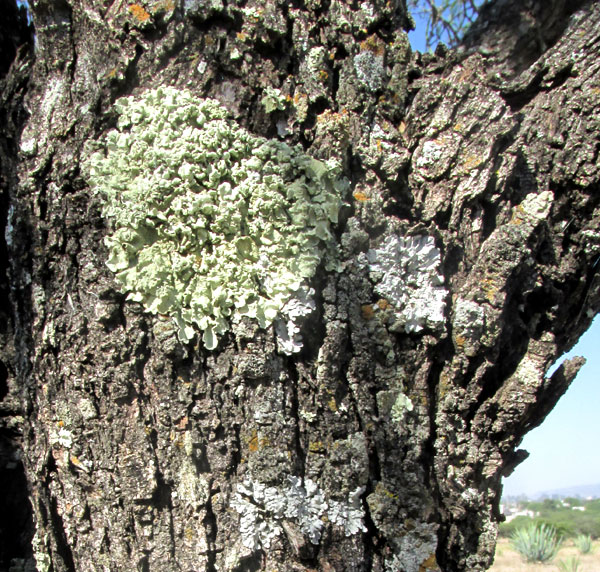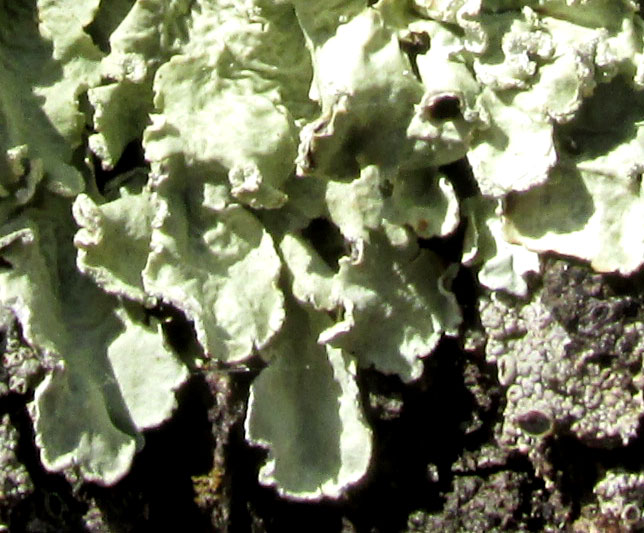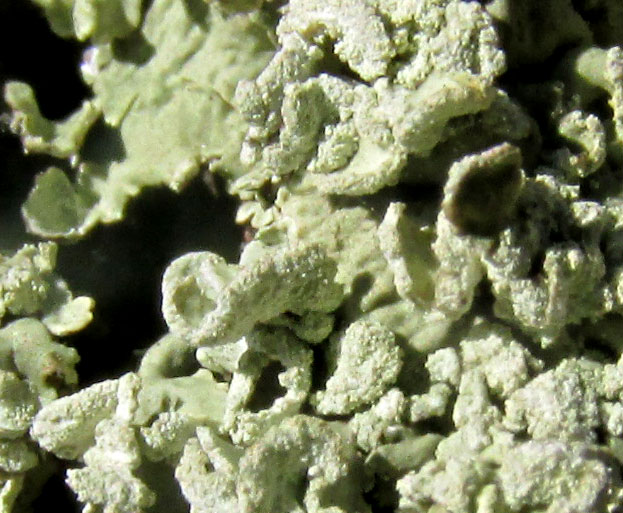Excerpts from Jim Conrad's
Naturalist Newsletter
entry dated March 31, 2023, issued from near Tequisquiapan, elevation about 1,900m (6200 ft), Querétaro state, MÉXICO
(~N20.55°, ~W99.89°)
POWDER-EDGED SPECKLED GREENSHIELD LICHEN

In the above photo, the long name Powder-edged Speckled Greenshield is being applied just to the slightly greenish, foliose, largest lichen appearing a little toward the top and to the left of center. The several lichens visible inhabit the bark of a Smooth Mesquite tree. For lichen identification, it's important to keep in mind that such lichen communities, though at first glance the gray splotches may all seem alike, often prove to be a mix of several species.

Above, a closer look at an edge of the above cluster shows flattish thalli with crinkly-edged lobes, the lobes often conspicuously upturned, and their margins sometimes encrusted with a kind of graininess. The "grains" are soredia, which provide the lichen with what may be its main mode of asexual reproduction. Soredia consist of microscopic threads of fungal hyphae wrapped around cells of green algae or cyanobacteria. When they're dislodged, wherever they end up, if conditions are right, they can grow into cloned copies of the mother lichen. Otherwise, the above thalli are noteworthy for offering such a plain surface area, not much wrinkled, not showing any tiny, dark specks representing pycnidia producing asexual spores, and showing no tendency to form cuplike apothecia, which would discharge sexually produced spores.

Toward the cluster's center, as seen above, two new features appear. First, a little left of center, something suggesting a cuplike apothecium appears to be forming, though it has a long way to go. Below it, even less convincing apothecia, if that's what they are, are seen. Inside other clusters of this species on other trees, not even such doubtful attempts at apothecia could be found. These lichens appear to be content with asexual reproduction.
The second feature to note in the above image is that the surfaces of many thalli, especially along their margins, assume a grainy texture. The graininess even extends up one side of the possible effort at an apothecium. These are more soredia.
The above pictures match those of others on the Internet labeled as FLAVOPUNCTELIA SOREDICA, the species name soredica probably taking note of the species' conspicuous soredia. The only English name I find for it is Powder-edged Speckled Greenshield, whose powdery edge and speckle also denote those soredia.
As the GBIF Occurrence Page for the species shows, our lichen enjoys a worldwide occurrence, though mostly it's been documented in North America and Mexico. Its LichenPortal.Org page describes it as inhabiting the bark of a wide variety of trees, mentioning mesquites, at low to quite high elevations. Also, important for IDing, LichenPortal mentions that the species' apothecia are rare, and then often immature, exactly as found on our mesquites. Also it says that pycnidia, to be seen as tiny black specks on thalli, also are rare or absent, as observed on our thalli.
In the 2019 study by Summaira Shaheen and others entitled "First Report of Dye Yielding Potential and Compounds of Lichens: A Cultural Heritage of Himalayan Communities, Pakistan," found that in Flavopunctelia soredica the compounds usnic and lecanoric acids produced a rich yellow dye. Orange shades have been produced by others. They also noted that, in general, lichen dyes on wool and silk require no mordant to remain fast to washing and exposure to sunlight, while natural dyes from other sources normally do require mordants to remain fast. Mordants often contain heavy metals hazardous to the environment and human health.